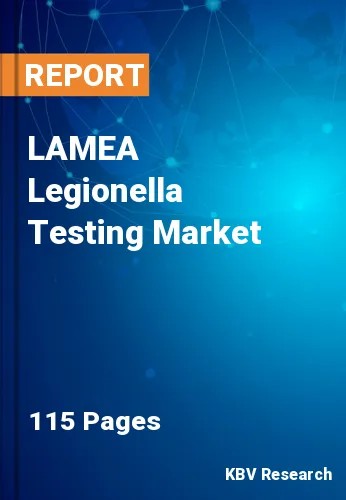The Latin America, Middle East and Africa Legionella Testing Market would witness market growth of 11.1% CAGR during the forecast period (2023-2030).
Low concentrations of Legionella bacteria are present in natural water sources, including reservoirs, lakes, and rivers, though the risk of human infection is minimal. However, outbreaks of respiratory illness may ensue when these microorganisms establish colonies and increase water systems within the constructed environment. From there, they can be transmitted via aerosol generation and inhaled by susceptible individuals. Industrial sources utilizing process water, hot and cold-water systems, and spa pools are susceptible to delivering potentially fatal pneumonia-like Legionnaires' disease (LD) or the more benign and self-limiting Pontiac and lochgoilhead fevers.
Evaporative cooling systems (ECS), which consist of cooling towers (CTs) or evaporative condenser units, are utilized to effectively cool industrial processes that necessitate the dissipation of excessive heat or freezing/chilling. Typically, these interfaces consist of a temperature differential between applied water and substantial airflows; consequently, the formation of aerosols is probable. Physical barriers on CTs, also known as drift eliminators, will capture the majority of aerosols, but not all. Hence, if the cooling water becomes tainted with Legionella, there exists the potential for the widespread dispersion of particulates, which could endanger personnel present at the site, adjacent establishments, or members of the public in close proximity.
Tobacco use is prevalent among teenagers aged 13 to 15 years in 29 Latin American countries, with males accounting for 15% and females for approximately 12%. Additionally, as per the National Library of Medicine, the Middle Eastern and North African regions demonstrated the highest diabetes prevalence in 2019, with a rate of 12.2%. Moreover, as per the International Diabetes Federation, with a projected increase of 86% to 136 million individuals by 2045. Therefore, the market in the region is being propelled by the rising prevalence of smokers and patients with diabetes.
The Brazil market dominated the LAMEA Legionella Testing Market, by Country in 2022, and would continue to be a dominant market till 2030; thereby, achieving a market value of $16,790.2 Thousand by 2030. The Argentina market is showcasing a CAGR of 12% during (2023 - 2030). Additionally, The UAE market would register a CAGR of 10.6% during (2023 - 2030).
Based on Type, the market is segmented into Polymerase Chain Reaction (PCR), Culture Media, Urine Antigen Testing (UAT), Serology, and Direct Fluorescent Antibody (DFA) Test. Based on End-User, the market is segmented into Clinical Laboratories, Hospitals & Clinics, and Others. Based on countries, the market is segmented into Brazil, Argentina, UAE, Saudi Arabia, South Africa, Nigeria, and Rest of LAMEA.
Free Valuable Insights: The Worldwide Legionella Testing Market is Projected to reach USD 578.9 Million by 2030, at a CAGR of 9.6%
The market research report covers the analysis of key stake holders of the market. Key companies profiled in the report include QuidelOrtho Corporation, Abbott Laboratories, Merck KGaA, Bio-Rad Laboratories, Inc., Thermo Fisher Scientific, Inc., Becton Dickinson and Company, BioMerieux S.A., IDEXX Laboratories, Inc., Eurofins Scientific SE and Qiagen N.V
By Type
By End-User
By Country
Our team of dedicated experts can provide you with attractive expansion opportunities for your business.

